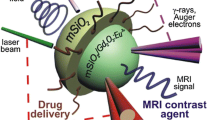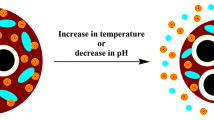Abstract
The aim of this study was the synthesis and structural characterization of SiO2–Al2O3 microspheres with SiO2 core and (100 − x)Al2O3·xFe2O3 (x = 0, 5, and 10 mol%) shell. Smooth spherical silica particles of uniform size around 1 μm have been synthesized as core material based on the Stöber method. In order to enhance the specific surface area, the silica particles were coated with a thin nanostructurated shell, about 15 nm, of aluminum and iron oxides (100 − x)Al2O3·xFe2O3 (x = 0, 5, and 10 mol%). The embedding of iron oxide in the covering shell was related to potential applications of these composite biomaterials for contrast enhancement in magnetic resonance imaging (MRI) and at the same time for local treatments of cancer by hyperthermia. The XRD results point out the amorphous structure of the obtained core–shell particles. The TEM images evidence continuous shell coating of silica spherical microparticles and the XPS analysis of the surfaces prove the occurrence of iron oxide on the outermost layer of the microspheres. Both FTIR and XPS results evidence the formation of Al–O–Si linkage proving that Al2O3 and SiO2 are chemically bonded in the investigated core–shell microspheres.

Highlights
-
Amorphous SiO2–Al2O3–Fe2O3 core–shell microspheres of mean diameter under 1.5 μm.
-
Silica core was synthetized using Stöber method.
-
Porous Al2O3–Fe2O3 shell of about 15 nm was nucleated by electrostatic attraction.
-
SiO2–Al2O3–Fe2O3 clay type nanocrystalline layer self-assembled as shell on SiO2 core.
-
Iron ions occur on the outermost layer of the core–shell microspheres.









Similar content being viewed by others

References
Weir A, Robinson P, Hogan B, Franklyn-Miller A (2017) MRI investigation for groin pain in athletes: is radiological terminology clarifying or confusing? Br J Sports Med 51:1185
Shazeeb MS, Kalpathy-Cramer J, Issa B (2017) MRI simulation study investigating effects of vessel topology, diffusion, and susceptibility on transverse relaxation rates using a cylinder fork model. Sci Rep 7:16223
Ogawa S, Lee TM, Kay AR, Tank DW (1990) Brain magnetic resonance imaging with contrast dependent on blood oxygenation. Proc Nat Acad Sci USA 87:9868–9872
Grenabo Bergdahl A, Wilderang U, Aus G, Carlsson S, Damber JE, Franlund M, Geterud K, Khatami A, Socratous A, Stranne J, Hellstrom M, Hugosson J (2016) Role of magnetic resonance imaging in prostate cancer screening: a pilot study within the Goteborg randomised screening trial. Eur Urol 70:566–573
Kasivisvanathan V, Rannikko AS, Borghi M et al. (2018) MRI-targeted or standard biopsy for prostate-cancer diagnosis. N Engl J Med 378:1767–1777
Taylor SA, Mallett S, Beare S et al. (2019) Diagnostic accuracy of whole-body MRI versus standard imaging pathways for metastatic disease in newly diagnosed colorectal cancer: the prospective Streamline C trial. Lancet Gastroenterol Hepatol 4:529–537
Sinharay S, Pagel MD (2016) Advances in magnetic resonance imaging contrast agents for biomarker detection. Annu Rev Anal Chem 9:95–115
Seo H, Choi I, Whiting N, Hu J, Luu QS, Pudakalakatti S, McCowan C, Kim Y, Zacharias N, Lee, Bhattacharya P, Lee Y (2018) Hyperpolarized porous silicon nanoparticles: potential theragnostic material for 29Si magnetic resonance imaging. Chemphyschem 19:2143–2147
Chen W, Xu N, Xu L, Wang L, Li Z, Ma W, Zhu Y, Xu C, Kotov NA (2010) Multifunctional magnetoplasmonic nanoparticle assemblies for cancer therapy and diagnostics (theranostics). Macromol Rapid Commun 31:228–236
Horcajada P, Chalati T, Serre C, Gillet B, Sebrie C, Baati T, Eubank JF, Heurtaux D, Clayette P, Kreuz C, Chang J-S, Kyu Hwang Y, Marsaud V, Bories P-N, Cynober L, Gil S, Ferey G, Couvreur P, Gref R (2010) Porous metal–organic-framework nanoscale carriers as a potential platform for drug delivery and imaging. Nat Mater 9:172–178
Ravindran Girija A, Balasubramanian S (2019) Theragnostic potentials of core/shell mesoporous silica nanostructures. Nanotheranostics 3:1–40
Han L, Lv Y, Asiri AM, Al-Youbi A, Tu B, Zhao D (2012) Novel preparation and near-infrared photoluminescence of uniform core-shell silver sulfide nanoparticle@mesoporous silica nanospheres. J Mater Chem 22:7274–7279
Carvalho A, Gallo J, Pereira DM, Valentao P, Andrade PB, Hilliou L, Ferreira PMT, Banobre-Lopez M, Martins JA (2019) Magnetic dehydrodipeptide-based self-assembled hydrogels for theragnostic applications. Nanomaterials 9:541
Fu R, Yan Y, Roberts C, Liu Z, Chen Y (2018) The role of dipole interactions in hyperthermia heating colloidal clusters of densely-packed superparamagnetic nanoparticles. Sci Rep 8:4704
Bumb A, Brechbiel MW, Choyke PL, Fugger L, Eggeman A, Prabhakaran D, Hutchinson J, Dobson PJ (2008) Synthesis and characterization of ultra-small superparamagnetic iron oxide nanoparticles thinly coated with silica. Nanotechnology 19:335601
Coroiu I (1999) Relaxivities of different superparamagnetic particles for application in NMR tomography. J Magn Magn Mater 201:449–452
Bumb A, Regino CAS, Perkins MR, Bernardo M, Ogawa M, Fugger L, Choyke PL, Dobson PJ, Brechbiel MW (2010) Preparation and characterization of a magnetic and optical dual-modality molecular probe. Nanotechnology 21:175704
Hafeli U (2002) Radioactive microspheres for medical applications. In: De Cuyper M, Bulte JWM (eds) Physics and chemistry basis of biotechnology, vol. 7, Kluwer Academic Publishers, New York, Boston, Dordrecht, London, Moscow, p 213–248
Cacaina D, Ylanen H, Simon S, Hupa M (2008) The behaviour of selected yttrium containing bioactive glass microspheres in simulated body environments. J Mater Sci Mater Med 19:1225–1233
Kalinowski M, Dressler M, Konig A, El-Sheik M, Rinke A, Hoffken H, Gress TM, Arnold R, Klose KJ, Wagner HJ (2009) Selective internal radiotherapy with yttrium-90 microspheres for hepatic metastatic neuroendocrine tumors: a prospective single center study. Digestion 79:137–142
Stober W, Fink A, Bohn E (1968) Controlled growth of monodisperse silica spheres in the micron size range. J Colloid Interface Sci 26:62–69
Cheng B, Zhao L, Yu J, Zhao X (2008) Facile fabrication of SiO2/Al2O3 composite microspheres with a simple electrostatic attraction strategy. Mater Res Bull 43:714–722
Hu CL, Rahanman MN (1993) SiC‐whisker‐reinforced Al2O3 composites by free sintering of coated powders. J Am Ceram Soc 76:2549–2554
Fyfe CA, Bretherton JL, Lam LY (2001) Solid-state NMR detection, characterization, and quantification of the multiple aluminum environments in US-Y catalysts by 27Al MAS and MQMAS experiments at very high field. J Am Chem Soc 123:5285–5291
Wallidge GW, Anderson R, Mountjoy G, Pickup DM, Gunawidjaja P, Newport RJ, Smith ME (2004) Advanced physical characterisation of the structural evolution of amorphous (TiO2)x (SiO2)1−x sol-gel materials. J Mater Sci 39:6743–6755
Todea M, Turcu RVF, Frentiu B, Tamasan M, Mocuta H, Ponta O, Simon S (2011) Amorphous and nanostructured silica and aluminosilicate spray-dried microspheres. J Mol Struct 1000:62–68
Kooli F, Yan L, Tan XS, Zheng J (2014) Organoclays from alkaline-treated acid-activated clays. J Therm Anal Calorim 115:1465–1475
Komadel P (2003) Chemically modified smectites. Clay Miner 38:127–138
Todea M, Muresan-Pop M, Vulpoi A, Simon S, Eniu D (2018) Heat treatment effect on structure and in vitro bioactivity of titanosilicatemicrospheres. Appl Surf Sci 457:838–845
De Escobar CC, Dartora MH, Campo LF et al. (2014) The role of the sol-gel route on the interaction between rhodamine B and a silica matrix. J Sol–Gel Sci Technol 72:260–272
Capeletti LB, Dos Santos JHZ, Moncada E, Da Rocha ZN, Pepe IM (2013) Encapsulated alizarin red species: the role of the sol-gel route on the interaction with silica matrix. Powder Technol 237:117–124
Jung HY, Gupta RK, Oh EO, Kim YH, Whang CM (2005) Vibrational spectroscopic studies of sol–gel derived physical and chemical bonded ORMOSILs. J Non-Cryst Solids 35:1372–1379
Liu Y, Zeng F, Sun B, Jia P, Graham IT (2019) Structural characterizations of aluminosilicates in two types of fly ash samples from shanxi province, North China. Minerals 9:358
Angaji MT, Zinali AZ, Qazvini NT (2013) Study of physical, chemical and morphological alterations of smectite clay upon activation and functionalization via the acid treatment. World J Nano Sci Eng 3:161–168
Todea M, Turcu RVF, Frentiu B, Simon S (2016) FTIR and NMR evidence of aluminosilicate microspheres bioactivity tested in simulated body fluid. J Non-Cryst Solids 432:413–419
Chan YT, Kuan WH, Tzou YM, Chen TY, Liu YT, Wang MK, Teah HY (2016) Molecular structures of Al/Si and Fe/Si coprecipitates and the implication for selenite removal. Sci Rep 6:24716
Simon V, Cavalu S, Simon S, Mocuta H, Vanea E, Prinz M, Neumann M, Simon S (2009) Surface functionalisation of sol–gel derived aluminosilicates in simulated body fluids. Solid State Ion 180:764–769
Barr TL, Seal S, Wozniak K, J Klinowski J (1997) ESCA studies of the coordination state of aluminium in oxide environments. J Chem Soc Faraday Trans 93:181–186
Park JH, Lee YG, Oh SG (2011) Easy synthesis of highly monodispersed silica@M (M = Ag, Au, Pd, Pt) particles using thiol compounds as a connecting agent. J Ceram Process Res 12:456–461
Bhargava G, Gouzman I, Chun CM, Ramanarayanan TA, Bernasek SL (2007) Characterization of the “native” surface thin film on pure polycrystalline iron: a high resolution XPS and TEM study. Appl Surf Sci 253:4322–4329
Zhang H, Guo X, Zhang Q, Ma Y, Zhou H, Li J, Wang L, Deng Y (2008) Synthesis of dialkyl hexamethylenedicarbamate from1,6-hexamethylenediamine and alkyl carbamate over Y(NO3)3. J Mol Catal A: Chem 296:36–41
Iatsunskyi I, Kempinski M, Jancelewicz M, Zaleski K, Jurga S, Smyntyna V (2015) Structural and XPS characterization of ALD Al2O3 coated porous silicon. Vacuum 113:52–58
Yamashita T, Hayes P (2008) Analysis of XPS spectra of Fe2+ and Fe3+ ions in oxide materials. Appl Surf Sci 254:2441–2449
Franca R, Zhang XF, Veres T, Yahia L’H, Sacher E (2013) Core–shell nanoparticles as prodrugs: possible cytotoxicological and biomedical impacts of batch-to-batch inconsistencies. J Colloid Interface Sci 389:292–297
Renault O, Gosset LG, Rouchon D, Ermolieff A (2002) Angle resolved X-ray photoelectron spectroscopy of ultrathin Al2O3 films grown by atomic layer deposition. J Vac Sci Technol 20:1867–1876
He H, Barr TL, Klinowski J (1995) ESCA and solid-state NMR studies of allophane. Clay Miner 30:201–209
Graat PCJ, Somers MAJ (1996) Simultaneous determination of composition and thickness of thin iron-oxide films from XPS Fe 2p spectra. Appl Surf Sci 100-101:36–40
Acknowledgements
Financial support from Romanian National Authority for Scientific Research—UEFISCDI under PN-III-P4-ID-PCE-2016-0835 project is acknowledged.
Author information
Authors and Affiliations
Corresponding author
Ethics declarations
Conflict of interest
The authors declare that they have no conflict of interest.
Additional information
Publisher’s note Springer Nature remains neutral with regard to jurisdictional claims in published maps and institutional affiliations.
Rights and permissions
About this article
Cite this article
Todea, M., Muresan-Pop, M., Simon, V. et al. Synthesis and characterization of composite SiO2–Al2O3–Fe2O3 core–shell microspheres. J Sol-Gel Sci Technol 96, 395–404 (2020). https://doi.org/10.1007/s10971-020-05346-4
Received:
Accepted:
Published:
Issue Date:
DOI: https://doi.org/10.1007/s10971-020-05346-4



